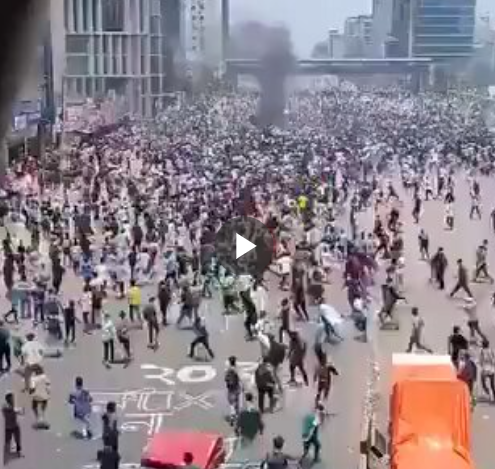Revolution is in the air again.
In response to escalating clashes over civil service job allocations, Bangladesh police enforced a strict curfew with a “shoot-on-sight” order on Saturday. Military forces patrolled parts of the capital as the country grappled with violence that has left scores dead and hundreds injured.
Police across Bangladesh have been given a shoot-on-sight order if civilians break curfew amid growing protests. @InesdLC reports on the violent and deadly clashes over a new job quota put in place by the government. https://t.co/6rlgy2VMyq pic.twitter.com/8atvmV8Czk
— World News Tonight (@ABCWorldNews) July 21, 2024
The curfew, which began at midnight, was temporarily lifted from noon to 2 p.m. for essential errands but is set to continue until 10 a.m. Sunday. Lawmaker Obaidul Quader, general secretary of the ruling Awami League party, stated that officers were authorized to fire on mobs if necessary.
The protests, primarily led by student groups, erupted weeks ago in opposition to a quota system that reserves up to 30% of government jobs for relatives of veterans who fought in Bangladesh’s 1971 war of independence. The unrest turned violent on Tuesday, with reports of at least 103 people dead, according to the Daily Prothom Alo newspaper.
Friday saw heightened violence, with Somoy TV reporting 43 fatalities. An Associated Press journalist witnessed 23 bodies at Dhaka Medical College and Hospital, though it was unclear if all the deaths occurred that day. On Thursday, 22 more deaths were reported as students attempted to “completely shut down” the country.
The U.S. Embassy in Dhaka described the situation as “extremely volatile,” noting that “hundreds to possibly thousands” were injured across Bangladesh. Despite these reports, Bangladeshi authorities have not released official figures on the casualties.
To curb further violence, authorities imposed the curfew after clashes between police and protesters in Dhaka and other cities. They also blocked mobile and internet services, causing several television news channels to go off the air, and the websites of most local newspapers were inaccessible. Key government websites, including those of Bangladesh’s central bank and the prime minister’s office, were reportedly hacked and defaced.
Adding to the chaos, around 800 inmates escaped from a prison in Narsingdi, north of the capital, after protesters stormed the facility and set it ablaze on Friday.
#Bangladeshstudentprotest: Police impose shoot-on-sight-order, soldiers patrol cities, death toll at 123
What is happening in Bangladesh?@SaroyaHem tells you more
Watch more at https://t.co/AXC5qRuO3J pic.twitter.com/dXReDu5nnk
— WION (@WIONews) July 21, 2024
These events underscore the deep-seated issues in Bangladesh’s governance and economy, and the frustrations of young graduates struggling to find employment. The unrest poses a significant challenge to Prime Minister Sheikh Hasina, who recently secured a fourth consecutive term in office after January’s elections, which were boycotted by main opposition groups.
Protesters argue that the quota system is unfair and favors Hasina’s supporters, advocating for a merit-based system instead. Hasina defends the quotas, emphasizing that veterans deserve high respect for their contributions to the independence war against Pakistan, regardless of their political affiliations.
Late Friday, representatives from both sides met to seek a resolution. Student leaders demanded reforms to the quota system, the reopening of student dormitories shut down by police, and the resignation of certain university officials who failed to protect campuses. Law Minister Anisul Huq indicated the government’s willingness to discuss these demands.
The opposition Bangladesh Nationalist Party (BNP) has backed the protests and pledged to organize its own demonstrations. While denying responsibility for the violence, the BNP criticized the ruling party for using the unrest for political gain.
#WATCH Shoot-On-Sight Order In Bangladesh. Amid #BangladeshViolence, nearly 1,000 Indian students have returned to India from Bangladesh through various land transit points or by flight. This week’s violence has killed at least 133 people. #Bangladesh #Bangladeshstudentprotest pic.twitter.com/IwqXUREKgw
— E Global news (@eglobalnews23) July 21, 2024
Historically, the Awami League and BNP have accused each other of inciting political chaos and violence, notably before the national election, which saw a crackdown on several opposition figures. In 2018, mass student protests led the government to halt the job quotas. However, in June, the High Court reinstated the quotas after relatives of 1971 veterans filed petitions. The Supreme Court has since suspended the ruling, pending an appeal hearing set for Sunday. Prime Minister Hasina has urged protesters to await the court’s decision.
Major Points:
- Bangladesh enforced a strict curfew with a “shoot-on-sight” order after violent clashes over civil service job quotas, leaving scores dead and hundreds injured.
- The protests, led mainly by student groups, oppose a quota system reserving 30% of government jobs for relatives of 1971 war veterans, sparking violence that killed over 100 people.
- Authorities blocked mobile and internet services and several news channels went off the air; key government websites were hacked and defaced amid the chaos.
- Around 800 inmates escaped from a prison in Narsingdi after protesters stormed and set the facility on fire.
- The unrest challenges Prime Minister Sheikh Hasina’s government, with demands for quota reforms and fair job allocation, while opposition groups back the protests, planning further demonstrations.
RM Tomi – Reprinted with permission of Whatfinger News



